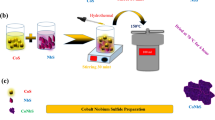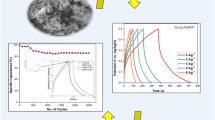Abstract
Carbon nanotubes (CNTs), which are classified as one-dimensional (1D) materials have attracted considerable interest in the scientific community due to their extraordinary electrical conductivity, enormous surface area, and chemical stability. Supercapattery, a device that combines the advantages of supercapacitors and batteries, has attained substantial interest due to its impressive power and energy densities. We have synthesized the binary FeCuS and FeCuS@CNTs nanocomposite through hydrothermal technique. Due to the synergistic effect, the efficiency of the electrode is improved with CNTs doping. The composite electrode FeCuS@CNTs showed an extraordinary specific capacity of 1217 Cg−1, exceeding the individual capacity values of iron sulfide (807 Cg−1) and copper sulfide (532 Cg−1). FeCuS@CNTs nanocomposite is used as the anode and activated carbon (AC) is used as the cathode in the fabrication of a supercapattery device. We achieved an extraordinary specific capacity of 342 Cg−1, surpassing previously reported values. The asymmetric device showed an extraordinary performance, with a power density (Pd) of 2352 W/Kg and an energy density (Ed) of 37 Wh/Kg. To check the cyclic stability, we evaluated the hybrid device for up to 1000 cycles, and it exhibited impressive capacity retention (CR) of 84% and Coulombic efficiency (CE) of 93%. Our results represent that FeCuS, with a 50:50 weight ratio and CNT doping, may be a better electrode material for asymmetric supercapacitor applications.









Similar content being viewed by others
Data availability
The data are available on request.
References
Y. Gogotsi, P. Simon, True performance metrics in electrochemical energy storage. Science 334(6058), 917–918 (2011)
D. Larcher, J.-M. Tarascon, Towards greener and more sustainable batteries for electrical energy storage. Nat. Chem. 7(1), 19–29 (2015)
P. Simon, Y. Gogotsi, B. Dunn, Where do batteries end and supercapacitors begin? Science 343(6176), 1210–1211 (2014)
A.U. Rehman et al., Highly efficient and stable layered AgZnS@WS2 nanocomposite electrode as superior charge transfer and active redox sites for energy harvesting device. J. Energy Storage 71, 108022 (2023)
T. Ejaz et al., Effect of Fe doping on the structural and electrochemical performance of Zn@CuO nanostructures for energy storage device. Solid State Ionics 399, 116312 (2023)
D.P. Dubal et al., Hybrid energy storage: the merging of battery and supercapacitor chemistries. Chem. Soc. Rev. 44(7), 1777–1790 (2015)
S. Khamlich et al., High performance symmetric supercapacitor based on zinc hydroxychloride nanosheets and 3D graphene-nickel foam composite. Appl. Surf. Sci. 405, 329–336 (2017)
K. Kaviyarasu et al., Synthesis and characterization studies of NiO nanorods for enhancing solar cell efficiency using photon upconversion materials. Ceram. Int. 42(7), 8385–8394 (2016)
Z. Gan et al., One-step electrofabrication of reduced graphene oxide/poly (N-methylthionine) composite film for high performance supercapacitors. J. Electrochem. Soc. 167(8), 085501 (2020)
A.M. Afzal et al., Exploring the charge storage mechanism in high-performance Co@ MnO2-based hybrid supercapacitors using Randles-Ševčík and Dunn’s models. J. Appl. Electrochem. (2023). https://doi.org/10.1007/s10800-023-01939-3
M. Ali et al., Synthesis and analysis of the impact of rGO on the structural and electrochemical performance of CoMnS for high-performance energy storage device. FlatChem 40, 100518 (2023)
F. Liu et al., Poly (azure C)-coated CoFe Prussian blue analogue nanocubes for high-energy asymmetric supercapacitors. J. Colloid Interface Sci. 628, 682–690 (2022)
C. Wu et al., Efficient pH-universal aqueous supercapacitors enabled by an azure C-decorated N-doped graphene aerogel. J. Colloid Interface Sci. 650, 1871–1880 (2023)
H. ul Hassan et al., The MOF-originated NiCu-POx/NGQD for efficient supercapattery devices and hydrogen evolution reaction. Int. J. Hydrog. Energy (2023). https://doi.org/10.1016/j.ijhydene.2023.04.303
L. Sun et al., Roles of carbon nanotubes in novel energy storage devices. Carbon 122, 462–474 (2017)
Z. Cao, B.B. Wei, A perspective: carbon nanotube macro-films for energy storage. Energy Environ. Sci. 6(11), 3183–3201 (2013)
A. Yasmeen et al., Cauliflower like porous structure of cobalt niobium sulfide@ carbon nanotubes for electrode materials to enhance the redox activity in the battery-supercapacitor hybrid device. Appl. Nanosci. 13(9), 6471–6487 (2023)
A. Eftekhari, Tungsten dichalcogenides (WS 2, WSe 2, and WTe 2): materials chemistry and applications. J. Mater. Chem. A 5(35), 18299–18325 (2017)
Y. Zhu et al., Carbon-based supercapacitors produced by activation of graphene. Science 332(6037), 1537–1541 (2011)
H.U. Hassan et al., Highly stable binary composite of nickel silver sulfide (NiAg2S) synthesized using the hydrothermal approach for high-performance supercapattery applications. Int. J. Energy Res. 46(8), 11346–11358 (2022)
M.Z. Iqbal et al., Optimizing electrochemical performance of sonochemically and hydrothermally synthesized cobalt phosphate for supercapattery devices. Int. J. Hydrogen Energy 46(29), 15807–15819 (2021)
J. Jean et al., Pathways for solar photovoltaics. Energy Environ. Sci. 8(4), 1200–1219 (2015)
V. Nicolosi et al., Liquid exfoliation of layered materials. Science 340(6139), 1226419 (2013)
M. Ali et al., 2D-TMDs based electrode material for supercapacitor applications. Int. J. Energy Res. 46(15), 22336–22364 (2022)
S. Tanwar et al., Transition metal dichalcogenide (TMDs) electrodes for supercapacitors: a comprehensive review. J. Phys.: Condens. Matter 33(30), 303002 (2021)
H. Tan et al., Large-scale carambola-like V2O5 nanoflowers arrays on microporous reed carbon as improved electrochemical performances lithium-ion batteries cathode. J. Energy Chem. 51, 388–395 (2020)
Y. Yan et al., Vanadium based materials as electrode materials for high performance supercapacitors. J. Power Sources 329, 148–169 (2016)
X. Xu et al., Vanadium-based nanomaterials: a promising family for emerging metal-ion batteries. Adv. Func. Mater. 30(10), 1904398 (2020)
P. He et al., Sodium ion stabilized vanadium oxide nanowire cathode for high-performance zinc-ion batteries. Adv. Energy Mater. 8(10), 1702463 (2018)
M. Yan et al., Water-lubricated intercalation in V2O5· nH2O for high-capacity and high-rate aqueous rechargeable zinc batteries. Adv. Mater. 30(1), 1703725 (2018)
N. Zhang et al., Rechargeable aqueous Zn–V2O5 battery with high energy density and long cycle life. ACS Energy Lett. 3(6), 1366–1372 (2018)
X. Xu et al., Bilayered Mg0. 25V2O5 H2O as a stable cathode for rechargeable Ca-ion batteries. ACS Energy Lett. 4(6), 1328–1335 (2019)
K. Huang et al., Two-dimensional transition metal carbides and nitrides (MXenes) for biomedical applications. Chem. Soc. Rev. 47(14), 5109–5124 (2018)
X. Xu et al., Alkaline earth metal vanadates as sodium-ion battery anodes. Nat. Commun. 8(1), 460 (2017)
L. Zhou et al., Interlayer-spacing-regulated VOPO4 nanosheets with fast kinetics for high-capacity and durable rechargeable magnesium batteries. Adv. Mater. 30(32), 1801984 (2018)
M. Bhushan et al., Ethylenediamine-assisted growth of multi-dimensional ZnS nanostructures and study of its charge transfer mechanism on supercapacitor electrode and photocatalytic performance. Nanotechnology 31(23), 235602 (2020)
R. Balu, S. Sagadevan, A. Dakshanamoorthy, A cost effective, facile hydrothermal approach of zinc sulfide decorated on graphene nanocomposite for supercapacitor applications. J. Nanosci. Nanotechnol. 19(11), 6987–6994 (2019)
A. Arulraj et al., Direct synthesis of cubic shaped Ag2S on Ni mesh as binder-free electrodes for energy storage applications. Sci. Rep. 9(1), 10108 (2019)
B. Cao et al., MOF-derived ZnS nanodots/Ti 3 C 2 T x MXene hybrids boosting superior lithium storage performance. Nano-Micro Lett. 13, 1–17 (2021)
L. Yao, S. Ju, X. Yu, Rational surface engineering of MXene@N-doped hollow carbon dual-confined cobalt sulfides/selenides for advanced aluminum batteries. J. Mater. Chem. A 9(31), 16878–16888 (2021)
X. Li et al., Rational design and construction of iron oxide and titanium carbide MXene hierarchical structure with promoted energy storage properties for flexible battery. J. Colloid Interface Sci. 631, 182–190 (2023)
D.Y. Kim et al., Controllable pore structures of pure and sub-millimeter-long carbon nanotubes. Appl. Surf. Sci. 566, 150751 (2021)
M. Li, Q. Wu, J. Shi, A simple route to synthesize CuS framework with porosity. J. Alloy. Compd. 489(2), 343–347 (2010)
M.S. Rahmanifar et al., A dual Ni/Co-MOF-reduced graphene oxide nanocomposite as a high performance supercapacitor electrode material. Electrochim. Acta 275, 76–86 (2018)
M.Z. Iqbal et al., A facile approach to investigate the charge storage mechanism of MOF/PANI based supercapattery devices. Solid State Ionics 354, 115411 (2020)
M. Azadfalah, A. Sedghi, H. Hosseini, Synthesis of nano-flower metal-organic framework/graphene composites as a high-performance electrode material for supercapacitors. J. Electron. Mater. 48(11), 7011–7024 (2019)
M.S. Javed et al., A high-performance flexible solid-state supercapacitor based on Li-ion intercalation into tunnel-structure iron sulfide. Electrochim. Acta 219, 742–750 (2016)
I. Hussain et al., Uniform growth of ZnS nanoflakes for high-performance supercapacitor applications. J. Energy Storage 36, 102408 (2021)
Q. Cheng et al., Ultrathin Ni-MOF nanosheet arrays grown on polyaniline decorated Ni foam as an advanced electrode for asymmetric supercapacitors with high energy density. Dalton Trans. 48(13), 4119–4123 (2019)
Acknowledgements
The authors are grateful to the Researchers Supporting Project number (RSP2023R407),
King Saud University, Riyadh, Saudi Arabia, for the financial support.
Author information
Authors and Affiliations
Contributions
MAY, HH, NM and AMA worked on experiment, data collection, analysis, and interpretation of results. MAY, HH, NM, AMA, MWI, AAG, SM, SAM, FA, MZY, AZ, and ZA performed the calculation and write the manuscript and helped during the calculation process and reviewed the manuscript.
Corresponding authors
Ethics declarations
Competing interests
The authors declare that they have no conflict of interest.
Ethical approval
The submitted work should be original and should not have been published elsewhere in any form or language.
Additional information
Publisher's Note
Springer Nature remains neutral with regard to jurisdictional claims in published maps and institutional affiliations.
Rights and permissions
Springer Nature or its licensor (e.g. a society or other partner) holds exclusive rights to this article under a publishing agreement with the author(s) or other rightsholder(s); author self-archiving of the accepted manuscript version of this article is solely governed by the terms of such publishing agreement and applicable law.
About this article
Cite this article
Yasir, M.A., Hassan, H., Muzaffar, N. et al. Effect of Fe doping on structural, morphological and electrochemical characteristics of CuS@CNTs composite electrode material to explore the Redox mechanism in supercapattery device. J Mater Sci: Mater Electron 34, 2266 (2023). https://doi.org/10.1007/s10854-023-11695-x
Received:
Accepted:
Published:
DOI: https://doi.org/10.1007/s10854-023-11695-x




